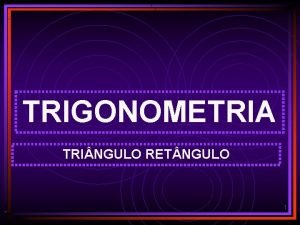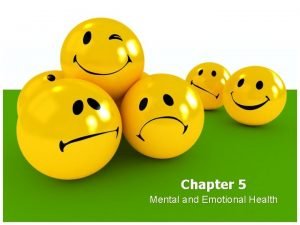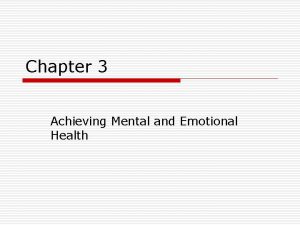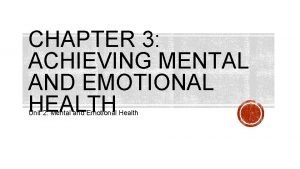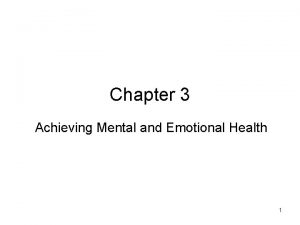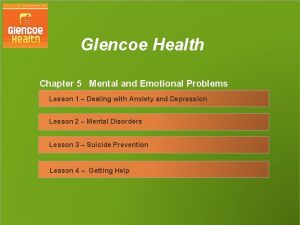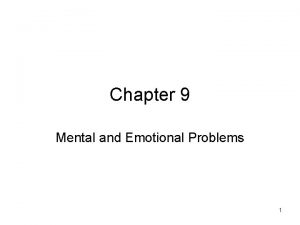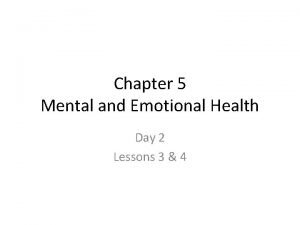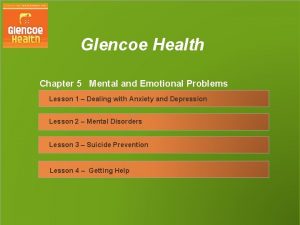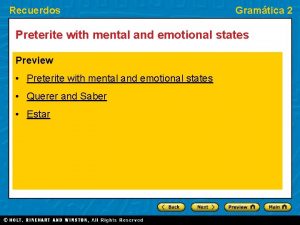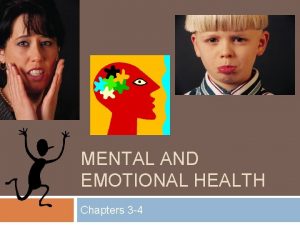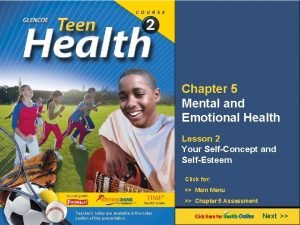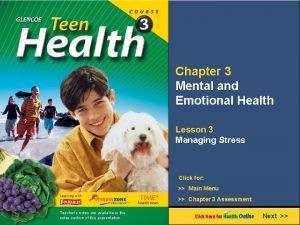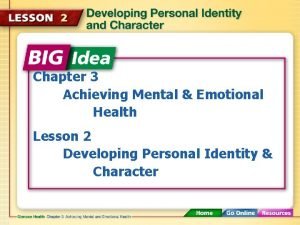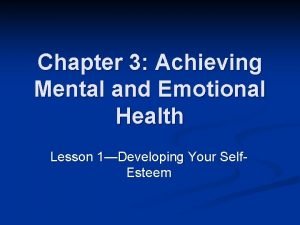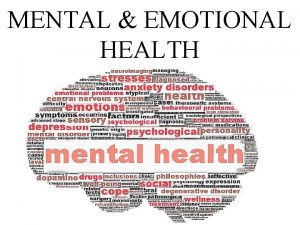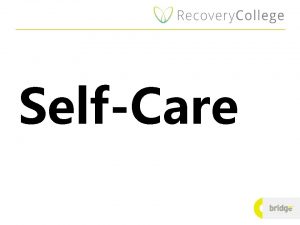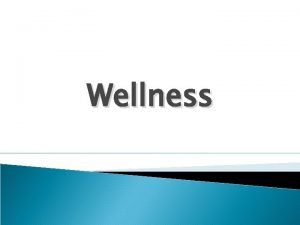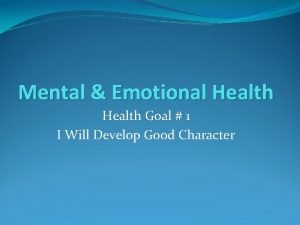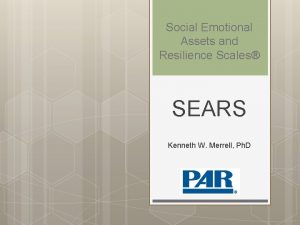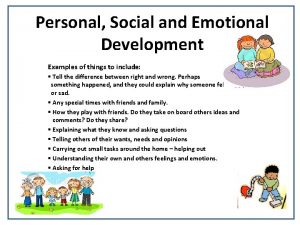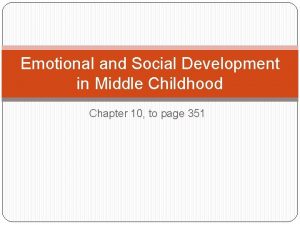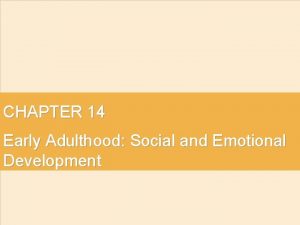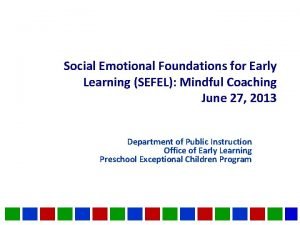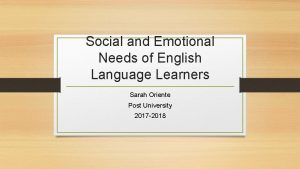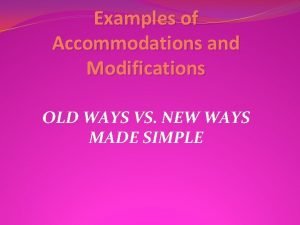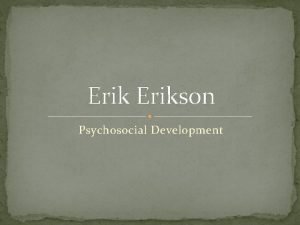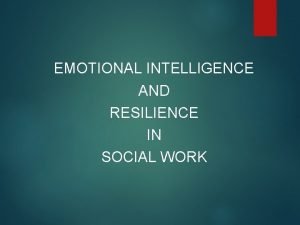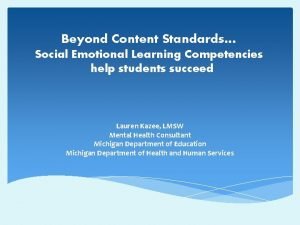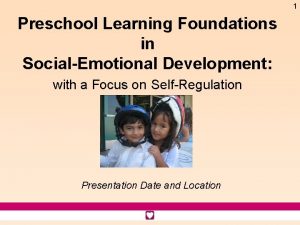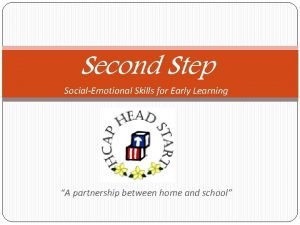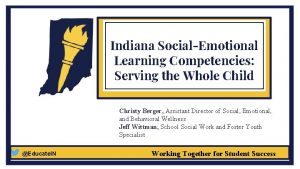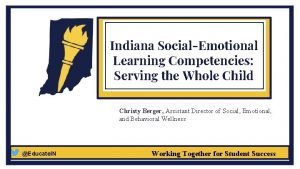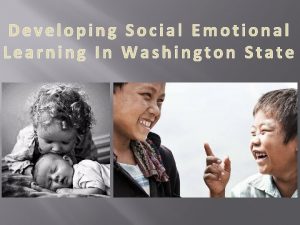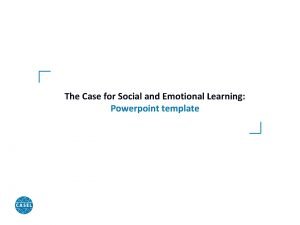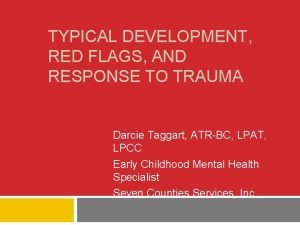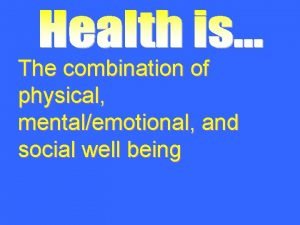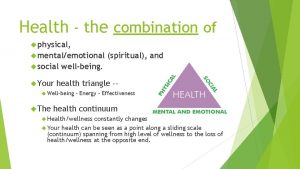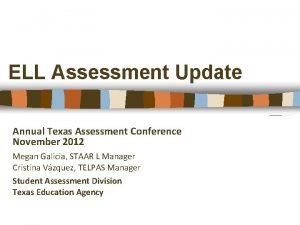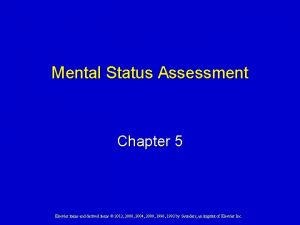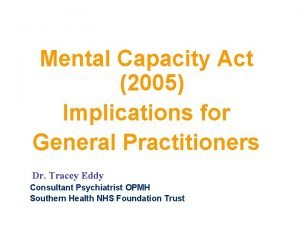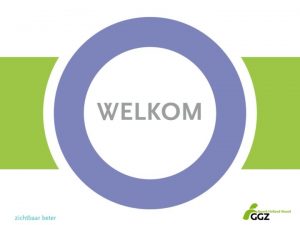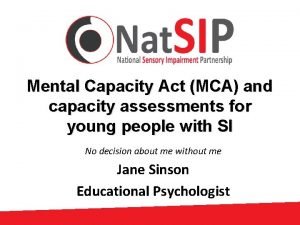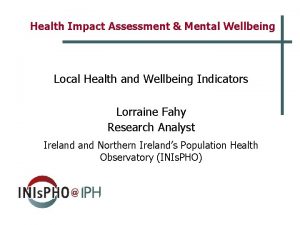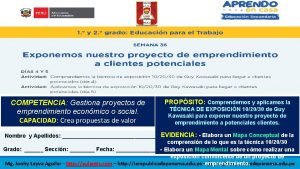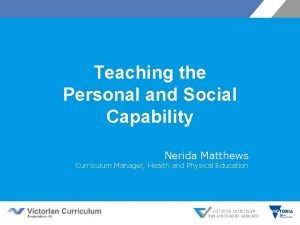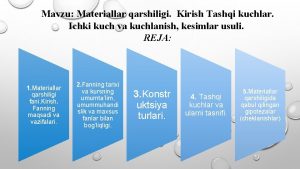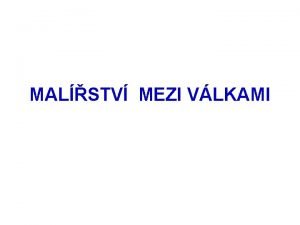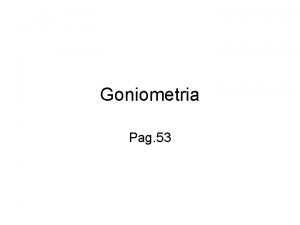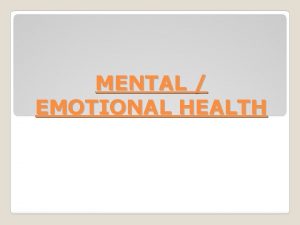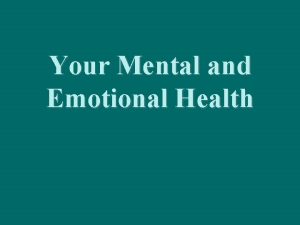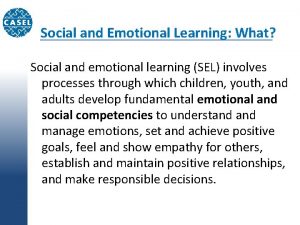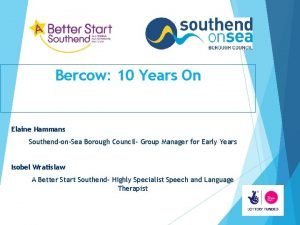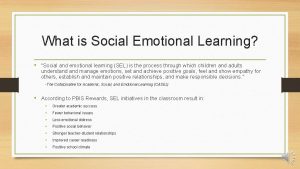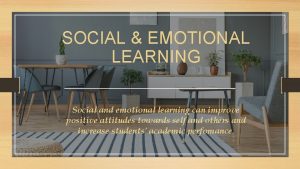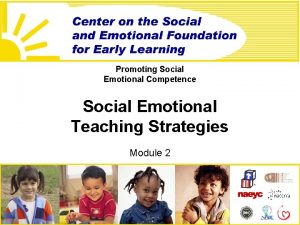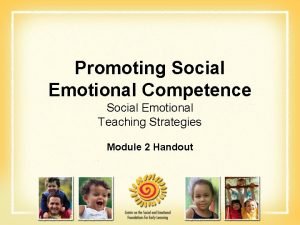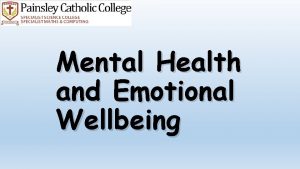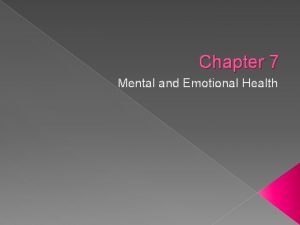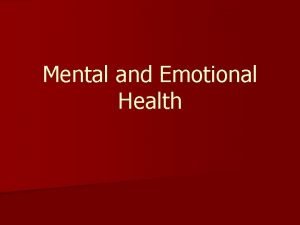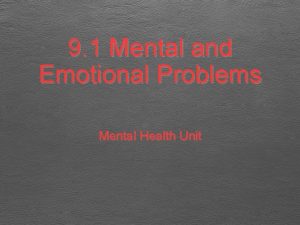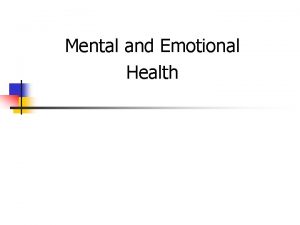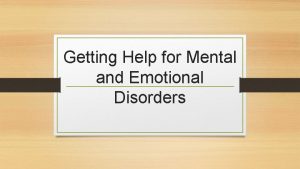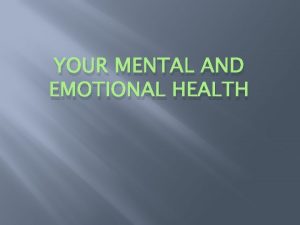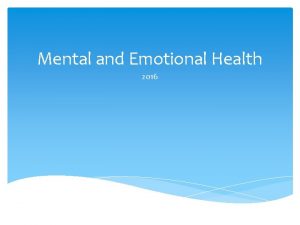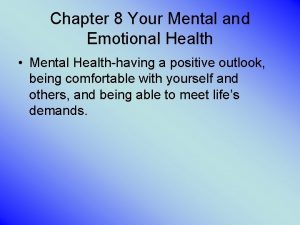SouthendonSea SEN Conference Assessment and Social Emotional Mental

















































































- Slides: 81

Southend-on-Sea SEN Conference Assessment and Social, Emotional, Mental Health Thursday 3 rd November

Agenda • Session 1: Assessment and SEND – a national update • Session 2: Working below national standard • Session 3: Supporting Social, Emotional and Mental Health – a whole school responsibility • Session 4: Embedding SEMH and Well-being in schools

Session 1 Assessment and SEND a national update


SEND Statistics • 14. 4 % of pupils in schools in England have SEN (1. 22 million pupils) • 11. 6% of pupils across all schools are on SEN Support • 2. 8% of pupils across all schools have a statement or an EHC Plan • 26. 8% of pupils have a primary need of moderate learning difficulty • SEN Support more prevalent in boys ( 14. 7% ) than girls (8. 2%) Statements/ EHCPs – Boys (4%) Girls (1. 5%) • 25. 9 % with a statement or EHC plan had a primary need of ASD Df. E Statistical First Release – National Statistics January 2016 5

The National Curriculum • Very prescriptive content by year group • Programmes of study • Attainment targets – By the end of each key stage, what pupils are expected to know, apply and understand the matters, skills and processes specified in the relevant programme of study • No levels of progress – “Can do” statements • Year 1 builds on work from Early Years Foundation Stage • Each year’s content builds on previous years • Does not dictate how to teach any subject

The Curriculum and SEND • Every teacher is responsible and accountable for the progress of all pupils • Differentiation • Effective research-based interventions • Personalised learning • Use of assessment to plan teaching and learning • Mastery! • The wider curriculum

Assessment

Tests, tests and more tests!

Assessments and Examinations • • Integrated development check at 2/2. 5 years Early Years Foundation Stage Profile (for now) Phonics check near the end of year 1 Teacher assessment at end of KS 1 – Interim Teacher Assessment framework for 2017 • National tests at end of KS 2 – Interim Teacher Assessment framework for 2017 • KS 3 teacher assessment only • KS 4 - Progress across a suite of 8 subjects

Key Stage 1 2016 Phonics • 81% met expected phonics standard in Year 1 • 91% met by end of Year 2 • 9% not meeting standard – how are we supporting these pupils? • SEN Pupils 42% - non SEN 86% KS 1 Assessments • 74% achieved expected standard in reading • 73% in mathematics • 65% in writing • Girls out perform boys in all subjects

Key Stage 2 2016 KS 2 Assessment • 53% achieved expected standard in reading, writing and mathematics • 72% achieved expected standard in SPAG • 66% achieved expected standard in reading • 74% achieved expected standard in writing (TA) • 57% of girls and 50% of boys reached expected standard (combined)

Primary accountability: 2016 Performance Tables Headline measures that will appear in performance tables in December 2016 • The percentage of pupils achieving the “expected standard” in English reading, English writing and mathematics at the end of KS 2 (combined measure across all three subjects) • The pupils’ average scaled score in English reading and mathematics at the end of KS 2 • The percentage of pupils who achieve at a higher standard in English reading, English writing and mathematics (Combined measure across all three subjects) • The pupils’ average progress in English reading, English writing and mathematics

Primary accountability: Floor Standard The floor standard is the minimum standard for pupil attainment and/or progress the government expects schools to meet • Above floor standard if: o At least 65% of pupils meet the expected standard in reading, writing and mathematics or o The school achieves sufficient progress scores in all three subjects • Coasting Schools o A school where the data showed that over a three-year period the school has failed to ensure that pupils reach their potential

KS 2 – KS 3 Transition • Scaled score and teacher assessment • Based on 2016 SATs – o 34% not at expected standard in reading o 28% not at expected standard in SPAG o 26% not at expected standard in writing • What does this mean to teachers in Year 7? • Language of assessment from each feeder school • Effective use of Year 7 Catch-up funding • How will this measure be used to predict GCSE results? • Access arrangements

GCSE • New GCSEs in English language, English literature and maths will be taught from September 2015. Other subjects added in 2016 and 2017 • A new grading scale of 9 to 1 will be used, with 9 being the top grade. • Assessment will be mainly by exam, with other types of assessment used only where they are needed to test essential skills • There will be new, more demanding content • Courses will be designed for two years of study – they will no longer be divided into different modules and students will take all their exams in one period at the end of their course • Resit opportunities will only be available each November in English language and maths

Accountability • Attainment 8 measures the average achievement of pupils in up to 8 qualifications • Progress 8 aims to capture the progress a pupil makes from the end of key stage 2 to the end of key stage 4. It compares pupils’ achievement – their Attainment 8 score – with the average Attainment 8 score of all pupils nationally who had a similar starting point (or ‘prior attainment’), calculated using assessment results from the end of primary school • Attainment in English and maths (A*-C) This measure looks at the percentage of pupils achieving A*-C in both English and maths. • The English Baccalaureate (EBacc) entry and achievement allows people to see how many pupils get an A*-C or above in core academic subjects at key stage 4.

What do we know about the future? • No changes to assessment until at least 2018 -19 • Full consultation on Primary Assessment in New Year • Early Years Foundation Stage Profile will remain in place for the 2017 to 2018 academic year • Key stage 1 grammar, punctuation and spelling test will remain nonstatutory for schools this year, with tests available for teachers to use if they choose • No statutory mathematics and reading resits on children’s arrival in year 7 - focus on the steps needed to ensure a child catches up lost ground. High-quality resit papers will be made available for teachers to use if they wish, as part of their ongoing assessments • A targeted package of support to make sure that struggling pupils are supported by teachers to catch up in year 7 • Improve the guidance for the moderation of teacher assessment

KS 1 Assessment and Reporting Arrangements 2017 • Tests are designed to be used with all pupils who have completed the KS 1 programme of study and are working at the overall level of the tests • Pupils should not take the tests if they : o Have not completed the KS 1 programme of study or o Are working below the overall standard of the KS 1 tests or o Are unable to participate even when using suitable access arrangements • The interim pre-key stage standards should be used to provide a statutory outcome for pupils that have not completed the programmes of study or who are working below the standard of the tests • Access arrangements can be used for a small number of pupils – based on normal classroom practice

KS 2 Assessment and Reporting Arrangements 2017 • Tests are designed to be used with all pupils who have completed the KS 2 programme of study and are working at the overall standard of the tests • Pupils should not take the tests if they : o Have not completed the KS 2 programme of study or o Are working below the overall standard of the KS 2 tests or o Are unable to participate even when using suitable access arrangements • The interim pre-key stage standards should be used to provide a statutory outcome for pupils that have not completed the programmes of study or who are working below the standard of the tests • Access arrangements can be used for some children – Access Arrangement Guidance – Evidence of normal way of working

At the moment we expect the learner to fit the system. . . Should we not be changing the system to fit the learner?

Session 2 Working below national standard

The Rochford Review • Review announced in July 2015 • Focused on pupils whose ability falls below the standard required to take national curriculum tests • Review considered how best to assess the attainment and progress of this group of pupils so that parents know how their children are doing and schools can be given appropriate credit for the work they do to support their pupils • Diane Rochford, Executive Headteacher of the John F. Kennedy School in East London chaired group of SEN experts • Recommendations published in December 2015 • Second part of review - P Scales

Interim Solution for 2015 -16 • P Scales remain in place • The review have considered whether P scales remain fit for purpose in the context of the new national curriculum as part of their longerterm recommendations • Created additional pre-key stage standards for the frameworks which each contain a number of positive ‘pupil can’ statements • Statements reflect the attainment of pupils who have not yet completed the relevant programme of study but have reached the chronological age that requires a statutory assessment outcome to be reported • The review will look to make longer-term recommendations for the statutory assessment of pupils working below the standard of national curriculum tests beyond 2016

Key Stage 1 - 2016 • At key stage 1, the statements reflect those areas of knowledge and understanding that the review has identified as core developmental milestones for progression onto the standards defined by the existing interim frameworks • Key Stage 1 – 1 additional standard o Foundations for the expected standard

Key Stage 2 - 2016 • At key stage 2, some of the statements in the additional standards are based on those elements of the key stage 1 curriculum that remain relevant for pupils who have not completed the key stage 2 programme of study. • They sit alongside some additional 6 statements which define expectations appropriate for pupils working at that standard and reflect the core knowledge and skills that this group of pupils need to progress • Key Stage 2 – 3 additional standards o Growing development of the expected standard o Early development of the expected standard o Foundations for the expected standard

Rochford Review – Final Report 10 Recommendations 1. The removal of the statutory requirement to assess pupils using P scales 2. The interim pre-key stage standards foe pupils working below the standard of NC test are made permanent and extended to include all pupils engaged in subject-specific learning 3. Schools assess pupils’ development in all four areas of need outlined in the SEND Code of Practice, but statutory assessment for pupils who are not engaged in subject-specific learning should be limited to cognition and learning 4. A statutory duty to assess pupils not engaged in subject-specific learning against the 7 aspects of cognition and learning and report this to parents and carers – responsiveness, curiosity, discovery, anticipation, persistence, initiation, investigation

Rochford Review – Final Report 5. Following recommendation 4, schools should decide their own approach to making these assessments according to the curriculum they use and the needs of their pupils 6. Initial Teacher training and CPD for staff in educational settings should reflect the need for teachers to have a greater understanding of assessing pupils working below the standard of national curriculum tests, including those pupils with SEND who are not engaged in subject-specific learning 7. Where there is demonstrable good practice in schools, those schools should actively share their expertise and practice with others. Schools in need of support should actively seek out and create links with those that can help and support them.

Rochford Review – Final Report 8. Schools should work collaboratively to develop an understanding of good practice in assessing pupils working below the standard of national curriculum tests, particularly across different educational settings. Schools should support this by actively engaging in quality assurance, such as through school governance and peer review 9. There should be no requirement to submit assessment data on the 7 areas of cognition and learning to the Df. E, but schools must be able to provide evidence to support a dialogue with parents and carers, inspectors, regional commissioners, local authorities, school governors and those engaged in peer review to ensure robust and effective accountability 10. Further work should be done to consider the best way to support schools with assessing pupils with EAL

Guiding principles for the Rochford Review The following key principles have guided this work: • Every pupil should be able to demonstrate his or her attainment and progress • Parents and carers should receive meaningful information about the achievement and progress their child makes and should be involved appropriately in assessment processes • Any recommendations for the statutory assessment of these pupils should support schools in providing the opportunity for pupils to make the best progress possible • Assessment for pupils with SEND should take into account the complexity, nature and combination of SEND. It should take account of recent SEND reforms including the introduction of Education Health and Care plans (EHC plans)

Guiding principles for the Rochford Review • As far as possible, there should be one assessment system for all pupils, so long as this is meaningful and appropriate for the pupils in question • Equality is not always about inclusion. Sometimes equality is about altering the approach according to the needs of the pupils • The recommended approach to assessment should cover key milestones in English/literacy and mathematics/numeracy • Curriculum should drive assessment and not the other way round • Key milestones should be clear and unambiguous • It should be possible to assess movement between milestones objectively. It should also be possible to assess the application of knowledge, understanding and skills in a range of different contexts • The language used to describe the achievements and progress of these pupils should always be positive, inclusive and should be jargon free

Key stage 1 (R & M) Interim teacher assessment framework Working at greater depth in the expected standard Working at the expected standard Working towards expected standard Interim Pre KS 1 standards Foundations for the expected standard Rochford Recommendation Emerging to the expected standard Entry to the expected standard

Key stage 2 (R, M & W) Interim teacher assessment framework Working at greater depth in the expected standard (Writing only) Working at the expected standard Working towards expected standard (Writing only) Interim Pre KS 1 standards Growing development of the expected standard Early development of the expected standard Foundations for the expected standard Rochford Recommendation Emerging to the expected standard Entry to the expected standard

Cognition and Learning for pupils with SLD/PMLD • Builds on research form the Complex Learning Difficulties and Disabilities Project (2011) o http: //complexld. ssatrust. org. uk/project-information. html • Early development in cognition and learning centres on a range of skills that enable pupils to engage in learning situations • CLDD Project identified 7 areas of engagement – not viewed in a hierarchical sense – guide for assessing pupil’s effective engagement in the learning process • Observational framework to monitoring the varying ways a pupil demonstrates attention, interest and involvement in new learning and provides scaffold for pupil to become autonomous in the acquisition of a new skill or concept • Skills and concepts acquired will give foundations for moving on to later subject-specific learning.

7 areas of Engagement Investigation Responsiveness Initiation Curiosity Persistence Discovery Anticipation

What does this mean for schools? • Schools should identify the right means of statutory assessment for all pupils at the end of key stages 1 and 2 • The decision to enter a pupil for national curriculum tests remains the responsibility of the headteacher • If pupils are able to answer the easiest questions, they should be entered for the test • The interim pre-key stage standards should be used for any pupil not entered for the test to provide a statutory assessment outcome for the pupil • Precise information for KS 2 to KS 3 transition is crucial

Going forward • Change the style of teaching and learning • Remove the linear progression that levels gave us (tracking systems) • Rapid and sustained progress • Teach fewer things but at a greater depth - Mastery • Additional strategies and activities for those not meeting objectives • Questions and answers to assess how pupil is thinking and identify gaps in learning • Not just about a right or wrong answer • Giving pupils opportunity to fail and reflect • School decides the key objectives for each subject • Not just teaching what we are going to assess • Need to offer a broad and balanced curriculum for all pupils

Consider! • • Whole School Assessment Policy Language of assessment Transition SEN Information Report • • Disapplication - school data or pupil Access arrangements Social, Emotional and Mental Health Needs Screening and diagnostic assessment

Access Arrangements • KS 1 and KS 2 - Access arrangements should be based primarily on normal classroom practice for pupils with particular needs. They must never provide an unfair advantage • KS 4 – JCQ - Adjustments for candidates with disabilities and learning difficulties : Access Arrangements and Reasonable Adjustments • Specialist Assessor – Successfully completed a post-graduate course at or equivalent to Level 7, including at least 100 hours relating to individual specialist assessment and/or an appropriately qualified psychologist registered with the Health & Care Professions Council and/or a specialist assessor with a current Sp. LD Assessment Practising Certificate, as awarded by Patoss, Dyslexia Action or BDA • Normal way of working

Session 3 Supporting Social, Emotional and Mental Health a whole school responsibility

What is Mental Health? The World Health Organisation (WHO) defines mental health as: A state of well-being in which the individual realises his or her own abilities, can cope with normal stresses of life, can work productively and fruitfully, and is able to make a contribution to his or her community (WHO, 2007) Emotional well-being is described by the National CAMHS Support Service (2011) as: A positive state of mind and body, feeling safe and able to cope, with a sense of connection with people, communities and the wider environment

What is mental ill- health? • Mental health problems are relatively common, affecting 30%-40% of all children at some time during childhood. They are likely to be mild and transient and may arise from a broad range and combination of congenital, physiological or environmental factors • Mental health disorders are usually diagnosed by a health professional based on observations of a pattern of extended behaviour. There are four main categories, emotional disorder (anxiety) conduct disorder (anti-social behaviour), hyperkinetic disorder (ADHD) and less common disorders such as ASD • Mental illness refers to very severe conditions including severe depressive illness, eating disorders and psychotic disorders such as schizophrenia

The challenge for schools • 1 in 10 children and young people have a clinically diagnosed mental health disorder and/or emotional and behaviour problems • 1 in 7 children and young people have a less severe need that interferes with development and learning • Children and young people with a learning disability are six times more likely to have mental health needs than their peers • Anti-social behaviour and conduct disorder affect over 5% of children and young people (more prevalent in boys) • Anxiety and depression affect 4% of children and young people • Suicide is now one of the most common causes of death in youth and is rising • Over the last ten years there has been a 68% increase in the number of young people admitted to hospital due to self-harming

The challenge for schools • Early intervention funding received by local authorities has fell in last 5 years - £ 3. 2 billion (10/11) £ 1. 4 billion (15/16) • 72% of children and young people in care have emotional and social difficulties • 95% of imprisoned young offenders have a mental health disorder • More that half of all adults with mental health problems were diagnosed in childhood but less than half were treated appropriately at the time • There is no mandatory training requirement for Initial Teacher Trainees or for continuing professional development “A 20 th century workforce working with 21 st century children and young people”

Why now? • Increased numbers of children and young people diagnosed with a mental health disorder • Change in category of need in SEND Code of Practice 2015 to emotional, social and mental health needs which requires schools to be the first-tier response to mental health needs • Mental health and behaviour in schools – Departmental advice for school staff (Df. E Updated March 2016) • Governments commitment to helping schools ensure that more children develop a set of character traits, attributes and behaviours that underpin success in education and work

Why now? • Reduction in funding for LA and NHS resulted in less qualified and specialist front-line staff supporting early intervention work • NHS England Future in Mind – Promoting, protecting and improving our children and young people’s mental health and wellbeing (2015) • Personal, social, health and economic education (PSHE) integral part of national curriculum • Ofsted judgement on personal development, behaviour and welfare • 21 st Century life!

Curriculum, teaching and learning A positive ethos and environment Pupil Voice Supportive Leadership and Management Targeted Support Working with parents and families Staff Development Identifying need and monitoring impact

Leadership and Management • Member of leadership team to champion mental health and wellbeing • A governor with knowledge and understanding of emotional health and wellbeing • Engagement of leadership and management and their capacity to manage change • All school policies, processes and procedures need to be developed with mental health as a key feature • A commitment to being responsive to children and young people’s need

School ethos and environment • A clear and agreed ethos and culture that accords value and respect to all and that clearly sets out that ‘mental health and well being is everyone’s business’ • School wide commitment and integration across all school practice • Culture and environment needs to be conducive with the mentally healthy approach • Relationships between staff and pupils, and between pupils, promotes student wellbeing and engenders a sense of belonging to and liking school • Provide an emotionally secure and safe environment that prevents any form of bullying, violence and negative behaviours and that nurtures and encourages pupil’s sense of self-worth and self-efficacy

Curriculum, teaching and learning • Programmes of social and emotional learning are an integral part of whole school curriculum • PSHE is taught across the school as a dedicated subject • Assessment , record keeping and reporting systems are in place to celebrate achievement • The school has a range of tools and strategies to engage with pupils and gain their feedback on teaching and learning • Develop opportunities for specific curricula focus – transition, preparation for exams or locally topical issue • Develop alternative curriculum opportunities for those pupils who are unable to access the standard curriculum • All teachers understand the individual needs of their pupils and provide differentiated work to meet those needs

Pupil voice and involvement • Have opportunities to participate in activities that encourage belonging • Have opportunities to participate in decision making • Have opportunities to celebrate academic and non-academic achievements • Have their unique talents and abilities identified and developed • Have opportunities to develop a sense of worth through taking responsibility for themselves and others • Have opportunities to reflect • Have access to appropriate support that meets their needs • Have a right to be in an environment that is safe, clean, attractive and well cared for • Be surrounded by adults who model positive and appropriate behaviours, interactions and ways of relating at all times

Staff development, health and wellbeing All staff should: • Have their individual needs recognised and responded to in a holistic way • Have recognition of their work-life balance and are able to access proactive strategies and systems to support them at times of emotional needs in both the short term and the long term • Have their mental health and well-being reviewed regularly • Feel valued and have opportunities to contribute to decision making processes and celebrate and recognise success • Be able to carry out roles and responsibilities effectively and are provided with opportunities for CPD both personally and professionally • Have their unique talents and skills recognised and opportunities are provided for development • Have time to reflect

Identifying need and monitoring impact • • Schools use a variety of tools to assess and understand pupils’ emotional health and wellbeing needs Questionnaires and feedback forms are used to gain understanding of emotional, social and mental health concerns within school Consistent disruptive or withdrawn behaviours can be an indication of an underlying need Assessment to determine whethere are causal factors such as undiagnosed learning difficulties, difficulties with speech and language or mental health issues Early identification leading to early intervention Involvement of parents from the earliest stage – listen to what they have to say – listen to what pupils have to say Schools very aware of who their vulnerable young people are and systems are in place to monitor closely Where external circumstances are the contributing factor then involving outside agencies and professionals is imperative – housing, health etc.

Working with parents and families • Understand that the family has a key role in influencing emotional health and wellbeing • Be recognised for their significant contribution to children and young people’s education • Be welcomed, included and work in partnership with schools and agencies • Be provided with opportunities where they can ask for help when needed • Be signposted to appropriate agencies for support • Be clear about their roles and expectations of their responsibilities in working in partnership with school • Have their opinions sought , valued and responded to • Have their strengths and difficulties recognised, acknowledged and challenged appropriately

Targeted support • Delay in identifying and meeting emotional wellbeing and mental health needs can have a far reaching effect on pupil’s lives • Some pupils are at far greater risk of experiencing poorer mental health and require specific help and support • Development of transformation plans which articulate the local offer of services for pupils’ health and well being • School nurses have an important role to play • Pupils value face-to-face interaction provided by a trusted adult • Provide a range of interventions that have been proven to be effective, according to the pupil’s needs • All pupils have access to pastoral care and support, as well as specialist services as appropriate • Develop peer mediation approach to offer peer-to-peer support

Whole school approach • Strong leadership and support for meeting the needs of vulnerable pupils • Behaviours that evidence respect for all pupils • Consistent rules and expectations to ensure the safety and well-being of all • Predictable routines • Immediate response to absence • Modelling of good relationships and communication by adults • Disciplinary procedures that are fair and consistent • Opportunity for reflection after an incident • Mutual support and collaboration • Training in building resilience is everybody’s business • High quality training for all staff in strategies to manage Mental Health and behaviour throughout the school • Pupil Profiles that express likes, dislikes, preferences and distribute to all staff

Key Questions 1. How is your school providing visible senior leadership emotional health and well-being? 2. How does your school’s culture promote respect and diversity? 3. What focus is given within the curriculum to social and emotional learning and promoting personal resilience, and how is learning assessed? 4. How does the school ensure all children have the opportunity to express their vies and influence decisions? 5. How are staff supported in relation to their own health and wellbeing and to be able to support student well-being? 6. How does the school assess the needs of children and the impact of interventions to improve well-being? 7. How does the school work in partnership with parents to promote emotional health and well-being?

Session 4 Embedding SEMH and Well-being in schools

Using the Mental Health Standards • The standards cover: o Leadership, management and managing change o Policy development o Curriculum planning, and resources, including working with outside agencies o Learning and teaching o School culture and environment o Giving children and young people a voice o Providing support services for children and young people o Staff professional development needs, health and welfare o Partnerships with parents/carers and local communities o Assessing, recording and reporting children and young people’s achievements

Developing an Effective Mental Health Policy • Do you have a Mental Health Policy? • Is Mental Health included in other policies? o Behaviour, Curriculum, PSHE, Safeguarding • Is there a member of staff with responsibility for Mental Health? • Do you know which groups are more likely to have mental health needs?

Categories of school-based mental health provision Prevention and Promotion Early Intervention Early identification, triage and referral

Categories of school-based mental health provision • Prevention and Promotion o Facilitation and delivery of prevention and promotion services o Skills based o Teaching of skills, strategies and behaviours that will help protect from mental health problems o Character Education - Promoting resilience o Universal or targeted o Culture of valuing well-being o A school ethos that places high value on mental health and well being

Categories of school-based mental health provision • Early identification, triage and referral o Early identification of emerging emotional and behavioural problems o Use of monitoring and screening tools o Staff trained to understand are able to differentiate the severity of needs o Effective process of triage o Clear referral guidance – internal and external

Categories of school-based mental health provision • Early intervention o School-based early intervention support available to all pupils who require help o Targeted, evidence-based interventions o Specialist/trained staff o Directly employ or contract from agency o Requires joint agency working – School counsellors (school) – CAMHS (health) EPs (education)


Resources • Butterfly Print Ltd – Mental Health Journals & Mental Health Standards www. butterflyprint. co. uk

Resources • Butterfly Print Ltd – Mental Health Journals, Mental Health Standards www. butterflyprint. co. uk • Loggerhead Publishing – Social, Emotional, Mental Health and Wellbeing resources – Primary and Secondary http: //www. loggerheadpublishing. net/ • Hinton House - http: //hintonpublishers. com/ • TTS Special Direct http: //www. specialdirect. com/shops/sd/Default. aspx

Resources • The Well-Being Toolkit – Nurture Group Network – Tina Rae A training programme to build knowledge and skills in supporting the emotional health and mental wellbeing of children and young people http: //nurturegroups. org/news/wellbeing-toolkit-0

Mind-Ed

Strengths and Difficulties Questionnaire • www. sdqinfo. com • The Strengths and Difficulties Questionnaire (SDQ) is a brief behavioural screening questionnaire about 3 -16 year olds • Scores indicate normal, borderline and abnormal, both for the difficulties they are encountering and the impact on relationships and learning • Can be completed by both teacher and parent to enable comparative results • Version of SDQ for pupils 11+ to complete themselves • An abnormal score identifies those struggling with high levels of psychological difficulties • Referral to CAMHS


Measures of Children’s Mental Health & Psychological Wellbeing – GL Assessment • • • A unique portfolio of assessments authored by highly-respected professionals from across the fields of educational and clinical development, designed to help all levels of school staff and clinical practitioners screen and respond to children's mental health needs quickly Schools are the first response to SEMH and need to identify the mental health needs of pupils early, so that wellbeing can be promoted and specialist help provided quickly where it is necessary It is an ideal tool for identifying the appropriateness of advice, consultation or proposed referrals The portfolio speeds up the assessment and diagnosis of children’s mental health requirements to support early intervention It provides one source of paper-based assessments for analysing the development of healthy social and emotional skills Clear advice on the next steps following assessment is provided and simple scoring means that teachers can quickly identify pupils who need referral and specialist intervention

PASS - Pupil Attitudes to Self and School – GL Assessment • An all-age attitudinal survey that provides a measurement of a pupil’s attitudes towards themselves as learners and their attitudes towards school, suitable for pupils aged 4 to 18+ • It will inform teaching strategies and intervention programmes to help raise standards of attainment and pupil well-being • It will tackle challenging behaviour, • It will address attendance issues through the identification of those most risk at of playing truant, up to 12 months in advance • Truly understand the root-attitudinal factors that affect the behaviours of pupils', to aid effective target setting and highlight areas of development for every individual • Support emotionally vulnerable young people and those with possible mental health issues, to ensure those most at risk do not slip through the net

Resources • Mental Health and Behaviour in Schools – Df. E – Updated March 2016 https: //www. gov. uk/government/publications/mental-health-andbehaviour-in-schools--2 • Counselling in schools: A blueprint for the future – Departmental advice for school leaders and counsellors https: //www. gov. uk/government/publications/counselling-in-schools • PSHE education – PSHE Association – Teacher Guidance: Preparing to teach about mental health and emotional well-being https: //www. pshe-association. org. uk/curriculum-andresources/guidance-preparing-teach-about-mental-healthand

Resources • Young Minds http: //www. youngminds. org. uk/ Young Minds is the UK’s leading charity committed to improving the emotional wellbeing and mental health of children and young people • Future Minds http: //www. emotionalwellbeingschools. co. uk/ Futureminds offers a comprehensive service for emotional wellbeing and good mental health. We believe in working effectively with minimum involvement and in the minimum amount of time“

Resources • Place 2 Be http: //www. place 2 be. org. uk/ Place 2 Be is the leading UK provider of school-based mental health support, unlocking children's potential in the classroom - and beyond • Counselling Mind. Ed https: //www. minded. org. uk/course/category. php? id=15&viewtype=pr ogram Accessible, engaging e-learning for trainee and practising counsellors who want to work with children, young people and young adults

Resources • Mental health and bullying: a guide for teachers and other children’s workforce staff http: //www. anti-bullyingalliance. org. uk/send-resources/mental-health/ • Play Therapy UK (PTUK) http: //www. playtherapy. org. uk/ The largest and most progressive organisation governing therapeutic play and play therapy in the United Kingdom. • CLDD Briefing Packs http: //complexld. ssatrust. org. uk/project-resources/cldd-briefingpacks. html

Resources • Thrive https: //www. thriveapproach. co. uk/ Thrive is a specific way of working with all children that helps to develop their social and emotional well-being, enabling them to engage with life and learning • SEAL http: //webarchive. nationalarchives. gov. uk/20110809101133/http: //nsonl ine. org. uk/node/66394 Social and Emotional Aspects of Learning (SEAL): Improving behaviour, improving learning

Resources • NHS Choices Website - Young People and Mental Health http: //www. nhs. uk/Livewell/youth-mental-health/Pages/Youth-mentalhealth-help. aspx • What works in promoting social and emotional well –being and responding to mental health problems in schools? http: //www. ncb. org. uk/media/1197143/ncb_framework_for_promoting_ well-being_and_responding_to_mental_health_in_schools. pdf • Closing the Gap: Priorities for essential change in Mental Health https: //www. gov. uk/government/publications/mental-health-priorities-for -change

Resources • Lightning Review: Access to Child and Adolescent Mental Health Services – May 2016 Children’s Commissioner http: //www. childrenscommissioner. gov. uk/ • Promoting children and young people’s emotional health and wellbeing – A whole school and college approach – Public Health England & Children and Young People’s Mental Health Coalition https: //www. gov. uk/government/publications/promoting-children-andyoung-peoples-emotional-health-and-wellbeing

Lorraine Petersen lorraine@lpec. org. uk @lorrainep 1957 www. lpec. org. uk
 Tg de 360
Tg de 360 Periodo della funzione
Periodo della funzione Formulas de arco duplo
Formulas de arco duplo Sen seni bil sen seni türü
Sen seni bil sen seni türü The intentional use of unfriendly or offensive behavior
The intentional use of unfriendly or offensive behavior Chapter 5 lesson 4 getting help answer key
Chapter 5 lesson 4 getting help answer key Chapter 5 lesson 2 mental disorders
Chapter 5 lesson 2 mental disorders Mental vs emotional
Mental vs emotional Chapter 3 achieving mental and emotional health
Chapter 3 achieving mental and emotional health Chapter 15 achieving mental and emotional health answer key
Chapter 15 achieving mental and emotional health answer key Chapter 5 lesson 3 suicide prevention answer key
Chapter 5 lesson 3 suicide prevention answer key Chapter 15 achieving mental and emotional health answer key
Chapter 15 achieving mental and emotional health answer key Chapter 3 achieving mental and emotional health
Chapter 3 achieving mental and emotional health Glencoe health chapter 5
Glencoe health chapter 5 Chapter 9 mental and emotional problems
Chapter 9 mental and emotional problems Chapter 15 achieving mental and emotional health answer key
Chapter 15 achieving mental and emotional health answer key Chapter 15 achieving mental and emotional health
Chapter 15 achieving mental and emotional health Glencoe health chapter 9
Glencoe health chapter 9 Is mental and emotional states preterite or imperfect
Is mental and emotional states preterite or imperfect Chapter 3 mental and emotional health
Chapter 3 mental and emotional health Chapter 3 achieving mental and emotional health
Chapter 3 achieving mental and emotional health Chapter 3 achieving mental and emotional health
Chapter 3 achieving mental and emotional health Chapter 3 achieving mental and emotional health
Chapter 3 achieving mental and emotional health Chapter 3 achieving mental and emotional health
Chapter 3 achieving mental and emotional health Chapter 15 achieving mental and emotional health
Chapter 15 achieving mental and emotional health Mental health triangle examples
Mental health triangle examples Mental vs emotional
Mental vs emotional Physical emotional mental spiritual
Physical emotional mental spiritual Mental emotional health
Mental emotional health Mental/emotional goals
Mental/emotional goals Chapter 20 mental health and mental illness
Chapter 20 mental health and mental illness Stress management jeopardy
Stress management jeopardy Social emotional assets and resilience scales pdf
Social emotional assets and resilience scales pdf Fictional character names
Fictional character names Social and emotional development in middle childhood
Social and emotional development in middle childhood Middle adulthood socioemotional development
Middle adulthood socioemotional development Emotional development for early adulthood
Emotional development for early adulthood Social and emotional wellbeing framework
Social and emotional wellbeing framework Sefel training
Sefel training Socioemotional development in late adulthood
Socioemotional development in late adulthood Social thinking adalah
Social thinking adalah Social thinking social influence social relations
Social thinking social influence social relations Social emotional needs of ell students
Social emotional needs of ell students General to specific words examples
General to specific words examples Generativity stage
Generativity stage Emotional resilience in social work
Emotional resilience in social work Social emotional learning standards michigan
Social emotional learning standards michigan Preschool learning foundations social emotional
Preschool learning foundations social emotional Second step social emotional skills for early learning
Second step social emotional skills for early learning Social emotional learning standards nj
Social emotional learning standards nj Idoe sel
Idoe sel Indiana social emotional learning competencies
Indiana social emotional learning competencies Washington state social emotional learning standards
Washington state social emotional learning standards Social emotional learning powerpoint
Social emotional learning powerpoint Social emotional observation checklist
Social emotional observation checklist Physical combination
Physical combination The combination of physical, mental and social well-being.
The combination of physical, mental and social well-being. Health is a state of complete physical
Health is a state of complete physical Biology staar
Biology staar Texas assessment conference
Texas assessment conference A full mental status examination example
A full mental status examination example Mental capacity assessment example
Mental capacity assessment example Gereedschapskoffer action
Gereedschapskoffer action 4 stages of mental capacity assessment
4 stages of mental capacity assessment Mental wellbeing impact assessment
Mental wellbeing impact assessment Mental wellbeing impact assessment
Mental wellbeing impact assessment Gestiona proyectos de emprendimiento económico o social.
Gestiona proyectos de emprendimiento económico o social. Sun yat sen and mao zedong
Sun yat sen and mao zedong Compare and contrast social darwinism and social gospel
Compare and contrast social darwinism and social gospel Personal and social capability
Personal and social capability Porfolio assessment
Porfolio assessment Static assessment vs dynamic assessment
Static assessment vs dynamic assessment Portfolio assessment matches assessment to teaching
Portfolio assessment matches assessment to teaching Romanika arhitektura
Romanika arhitektura Okhil chandra sen
Okhil chandra sen Sen - 1
Sen - 1 Eğitim bir sen'den istifa formu doldurulmuş örneği
Eğitim bir sen'den istifa formu doldurulmuş örneği Sen żyrafy
Sen żyrafy Ajratilgan kesim
Ajratilgan kesim Sen vyvolaný letem včely kolem granátového jablka
Sen vyvolaný letem včely kolem granátového jablka Test goniometria doc
Test goniometria doc Duygularına dikkat et düşüncelerine dönüşür
Duygularına dikkat et düşüncelerine dönüşür


